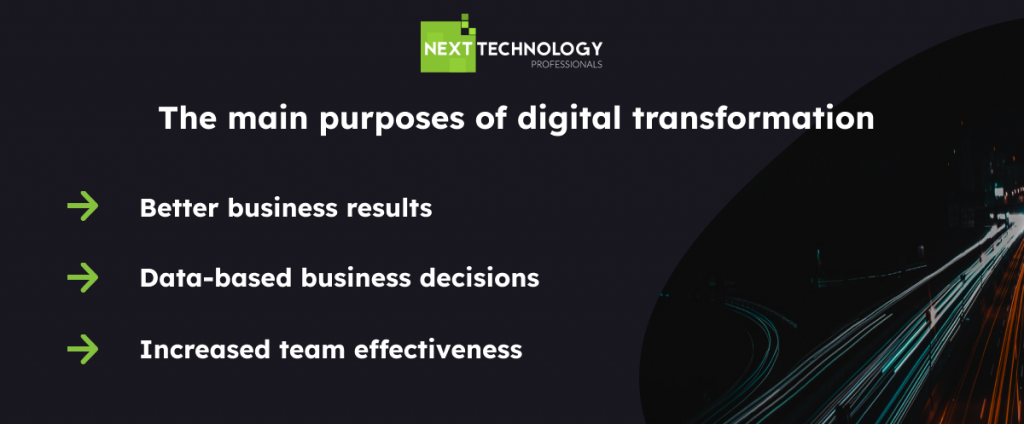The COVID-19 pandemic has accelerated digitization in many companies. Businesses had to move their activities to the online zone at an express pace. Unfortunately, it was not easy, and not everyone succeeded.
What mistakes do you need to avoid, and what is the key to success? In this article, we have gathered insights and tips that we want to share with you.
What is Digital Business Transformation?
87% of senior business leaders consider digitalization as a priority.
Source: Gartner
In short, digital transformation is the process of the integration of digital technology into all areas of a business. It revolutionizes almost every activity related to operating and delivering value to customers. It’s also associated with some cultural changes in the company and requires implementing some crucial changes in the existing work of employees.
For a successful digital business transformation, you need to integrate three key components: business, technology and people. If all of them work in sync, you will achieve the best results.
Who Drives Digital Transformation?
Digitalization is primarily the responsibility of two groups:
- executives — responsible for the appropriate planning and preparation of this process, as well as for tailoring the relevant business activities to the needs and specifics of a company.
- software development team — responsible for the technical side of digitisation in order to modernise the company’s business processes.
The Main Purposes of Digital Transformation
Before we explain how to drive digital transformation in your business, let’s answer the question: why should you actually do it?

Better business results
Companies that choose to adopt digital transformation follow trends and stay ahead of the competition. Internal processes can become more efficient and effective, with the ability to scale as the business grows. Over time, digital transformation provides tools to generate gains in time and resources, strengthening business partnerships.
Data-based business decisions
Big data and business analytics are the future of every business. Tapping into a huge database of information about your business, your customers, and changes in the market, will allow you to predict the future of your business better. It means that you will prepare for it by making better, more informed and data-driven business decisions.
Increased team effectiveness
One of the biggest business problems we mentioned in the article “5 Biggest Business Frustrations In The Post-Covid Times” is the lack of employee engagement and motivation. We cited data there that indicates only 15% of employees worldwide feel engaged.
Employers are looking for new ways to create productivity improvements. One of the best solutions can be digital transformation helping employees to become more effective and help them with the most repetitive and tedious.
5 key steps to drive business digital transformation
95% of digital transformations fail to achieve or exceed expectations.
Source: Bain and Company
1. Plan and prioritize
As an entrepreneur, you surely know that a good plan is key to any successful business process. It also applies to digital transformation, so the first thing you should do is prepare a well-planned roadmap of actions that will allow you to achieve your goals. It will enable you to effectively manage priorities and resources, availability, even when new challenges, risks, or opportunities arise.
What should such an action plan contain?
- A step-by-step action plan for reframing your company infrastructure
- A consistent expenditure plan needed to achieve the defined objectives
- An assessment of qualification your employees, including needed training
- A list of your corporate technologies that need updates
- A list of specific goals of your digital transformation
Please note: Digital transformation involves multiple departments, and even if each department uses different roadmaps, they should have consistent goals and plans. Therefore, you should centralize where teams plan, cooperate and execute work to get a complete insight into the status of your everyday work.
2. Select people responsible for managing the digital transformation process
After planning, the next step to success is people. Or, more specifically, in this case, there are the people responsible for managing and driving your business’s entire digital digitization process. It would be best if you had trusted, reliable and experienced professionals who can plan, manage risk, and tailor actions to your company’s current situation.
Their strategies are going to be cross-functional because they will be related to key company goals and objectives. Therefore, they will also establish solid alignment between the process and the execution teams to build good relationships with employees playing a vital role in the digital transformation.
3. Use data and business analytics
As we mentioned before, digital transformation is related to data science and business analytics. Therefore, your next step should include considering how to create a strong data strategy and how to utilize it for your digital transformation.
To set a successful data strategy, you need reliable, well-prepared data and advanced business analytics that help you get the best insights. Moreover, you should remember that IT leaders need access to the right data, in real-time, presented in a way that is easy to analyze. Therefore, you should synchronize all data-collecting systems to improve work across the organization.
Remember: Data Science and Business Analysis are areas that require a lot of knowledge and experience. If your team lacks specialists in these areas, you should consider hiring professionals or outsourcing IT services.
4. Choose the right tools
As is the case with a technology project, tools are essential. At this stage, you need to analyze your goals carefully and choose solutions that will help you achieve them. Remember that in this case, there are no all-purpose solutions. Therefore, if you have no experience in this, it is worth scheduling a consultation with a company specialising in IT development, which will advise you on what best suits your business.
5. Create a digitalization-oriented corporate culture
The final step is to prepare your employees for digital transformation. You should be prepared that not everyone will be open to change. Especially older employees who are used to the traditional working model may feel uncomfortable. What’s more, there may be fears among some that machines will replace them. What should you do?
First of all, you should present a clear vision of your digital business transformation strategy among all employees. They need to understand that this process will improve all business processes and make their work better and more satisfying. Honesty, transparent communication, collaboration, and honesty are the key elements of success in this area.
Digital transformation is a future you cannot avoid. If you are ready but need support, contact us. Our experts are highly experienced in this field and will be happy to help you achieve the best results.




